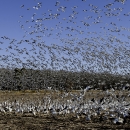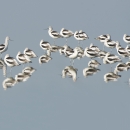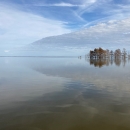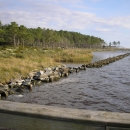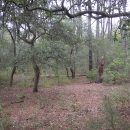About Us
Our Mission
Vision
Roanoke River National Wildlife Refuge will protect, enhance, and manage high quality habitat for a diversity and abundance of migratory birds, fish, and other wildlife. Through new and existing partnerships, the refuge will foster and practice sound conservation in land management and river flow management to assure the physical and biological integrity of the Roanoke River floodplain.
The refuge will provide compatible wildlife-dependent public use opportunities, including environmental education, interpretation, and recreation. The refuge will provide increased opportunities to learn about the ecological and cultural importance of the Roanoke River floodplain. The refuge will become a national destination, and activities on the refuge will contribute to the local economy.
Refuge Purpose(s)
Each unit of the National Wildlife Refuge System is established to serve a statutory purpose that targets the conservation of native species dependent on its lands and waters. All activities on those acres are reviewed for compatibility with this statutory purpose.
The purpose of Roanoke River National Wildlife Refuge, as reflected in the refuge’s authorizing legislation, is to protect and conserve migratory birds, and other wildlife resources through the protection of wetlands, in accordance with the following laws:
“...the conservation of wetlands of the Nation in order to maintain the public benefits they provide and to help fulfill international obligations contained in various migratory bird treaties and conventions…” (16 U.S.C., Sec. 3901(b), 100 Stat. 3583) (Emergency Wetlands Resources Act of 1986);
“...for use as an inviolate sanctuary, or for any other management purpose, for migratory birds…” (16 U.S.C. Sec. 664) (Migratory Bird Conservation Act of 1929);
“...for the development, advancement, management, conservation, and protection of fish and wildlife resources…” (6 U.S.C. Sec 742f(a)4); and
“...for the benefit of the United States Fish and Wildlife Service, in performing its activities and services…” (16 U.S.C. Sec. 742f(b)1) (Fish and Wildlife Act of 1956).
Other Facilities in this Complex
The refuge is managed as part of the Coastal North Carolina National Wildlife Refuge Complex. A National Wildlife Refuge Complex is an administrative grouping of two or more refuges, wildlife management areas or other refuge conservation areas that are primarily managed from a central office location. Refuges are grouped into a complex structure structure
Something temporarily or permanently constructed, built, or placed; and constructed of natural or manufactured parts including, but not limited to, a building, shed, cabin, porch, bridge, walkway, stair steps, sign, landing, platform, dock, rack, fence, telecommunication device, antennae, fish cleaning table, satellite dish/mount, or well head.
Learn more about structure because they occur in a similar ecological region, such as a watershed or specific habitat type, and have a related purpose and management needs.
There are 9 national wildlife refuges in the Coastal North Carolina National Wildlife Refuges Complex. The Project Leader for the Complex supervises the Refuge Managers who are responsible for managing these refuges. However, there are five distinct and separate administrative offices. Alligator River and Pea Island National Wildlife Refuges are administered from the Alligator River National Wildlife Refuge Headquarters in Manteo, NC. An administrative office at the Mackay Island National Wildlife Refuge Headquarters in Knotts Island, NC manages both Mackay Island and Currituck National Wildlife Refuges. An office at Mattamuskeet National Wildlife Refuge administers Mattamuskeet, Swanquarter, and Cedar Island National Wildlife Refuges. Pocosin Lakes National Wildlife Refuge, Roanoke River National Wildlife Refuge, Great Dismal Swamp National Wildlife Refuge, Back Bay National Wildlife Refuge, and Edenton National Fish Hatchery each have separate administrative offices.
All of the Coastal North Carolina National Wildlife Refuges, Great Dismal Swamp National Wildlife Refuge, Back Bay National Wildlife Refuge, and Edenton National Fish Hatchery are open to public visits for nature-based recreational enjoyment. Priority public uses are hunting, fishing, wildlife observation, wildlife photography, environmental education, and interpretation.
